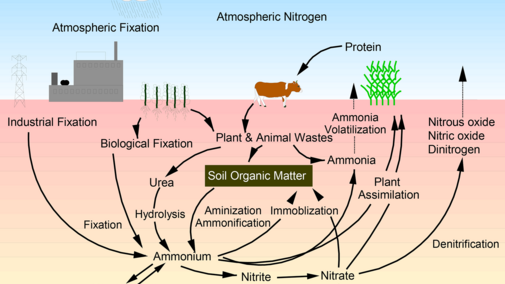Well, it seems not much has changed since the last article I wrote on nitrogen (N) management a few weeks back: more rain, more to come, and more uncertainty with regard to N. So, what do we do now and why I am not worried about the other nutrients? Why is it always about N? It’s all about the N cycle (Figure 1), which is how we conceptualize the inputs and outputs of N into our agronomic system. We can go into the cycle another day, but suffice to say, managers are most concerned with ensuring there is enough N in the field, and that what is applied such as fertilizer, manure, and irrigation water (inputs) is not lost to leaching, volatilization, and denitrification (outputs). I want to focus on a few common questions today.
What are the University’s objectives when recommending N management strategies?
We have several strategies for managing N, but it is important to understand our objectives and pair them with your own. Always start with your objective in mind.
Our objective for recommending N fertility in corn is to approximate the economic optimum return of N invested while being environmentally responsible. In other words, get the most bang for your buck of applied N from an economic perspective. Fortunately, this objective is not in conflict with the stewardship/efficiency objective, which is to ensure excessive amounts of N are not applied in order to guarantee an optimum yield.
What does that mean in practice?
With this objective in mind, we have an algorithm that has been verified through numerous trials and experiments throughout the state to be effective at approximating the economic optimum, but only when used correctly. (See Fertilizer Suggestions for Corn and the Corn Nitrogen Recommendations Calculator.) What do I mean? The algorithm attempts to account for many sources of N inputs already in the system, inputs like organic matter contributions, nitrate in the irrigation water, and residual N from the previous year and past rotations. This existing N must be accounted for to gain maximum efficiency, but that is easier said than done. Every year provides different growing environments even for the same field. As a result, there is error in this estimation. The algorithm is designed to recommend slightly more N than we think is appropriate to protect against error that would be averse to the grower’s interest economically.
But, what if I used the UNL algorithm or some other recommendation, applied a lot of N, and now am uncertain how much N is still there? Now, what do I do?
This is the most common question for N management, and the reason is because N is lost to leaching, volatilization, and denitrification. It’s a tricky nutrient to get ahold of. The algorithm we use is based on over 81 experiments, verified by 34 additional experiments. These experiments were conducted over several years and account for “average” losses across Nebraska’s corn production area.* We need to be concerned when we have severe weather that produces abnormal loss conditions.
The best way to be determine if previously applied N is still in the root zone is to soil sample at different depths to get a sense of where the bulk of the applied N resides at the moment. If the bulk of the N is at the 3-4 foot depth, further rain on wet soils will likely lead to leaching N below your corn’s root zone. At this point in the season the plants have taken up very little N and you can use the UNL algorithm to offset your soil N credits and revise your nitrogen management plan.
I applied starter fertilizer earlier this year, but now I have to replant. Should I use starter again?
Getting back to your objective, first, ask why the starter was used? If this was to encourage early growth and not to correct a known deficiency, we typically would not recommend a starter fertilizer application. Yield benefits are not consistently shown for using it. Even when corn purples early in the season from a phosphorus deficiency, this is generally not of concern. Any applied P in the furrow will still be there even if you replant. Phosphorus is not subject to the same losses as N. As far as the N is concerned, consider how little N is actually applied in furrow to your overall N strategy. If your starter serves as a base rate in your management system such as a 2x2 application, you’ll want to sample your soil. But, as soils warm up, the benefits of a starter diminish and we would not recommend another starter application. For more information see Using Starter Fertilizers for Corn, Grain Sorghum, and Soybeans (G361).
Related Resources
Fertilizer Suggestions for Corn, Nebraska Extension EC117, based on expected yield and existing nutrient levels in the soil, includes N recommendation equation.
Nutrient Management for Agronomic Crops in Nebraska, Nebraska Extension EC 155, with individual chapters on key soil nutrients and crop needs specific to Nebraska conditions.
*Documentation of research leading to UNL corn nutrient recommendations:
- Dobermann, A., C.S. Wortmann, R.B. Ferguson, G.W. Hergert, C.A. Shapiro, D.D. Tarkalson, D. Walters. 2010. Nitrogen Response and Economics for Irrigated Corn in Nebraska. Agron. J. 103:67-75.
- Wortmann, C.S., D.D. Tarkalson, C.A. Shapiro, A.R. Dobermann, R.B. Ferguson, G.W. Hergert, and D. Walters. 2010. N use efficiency for three cropping systems in Nebraska. Agron. J. 103:76-84.
- Wortmann, C.S., A.R. Dobermann, R.B. Ferguson, G.W. Hergert, C.A. Shapiro, D.D. Tarkalson, and D. Walters. 2009. High yield corn response to applied phosphorus, potassium, and sulfur in Nebraska. Agron. J. 2009 101: 546-555.m

